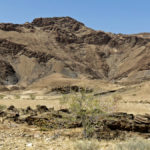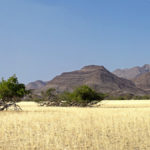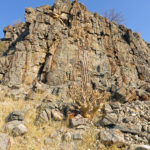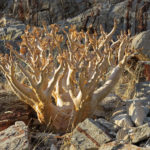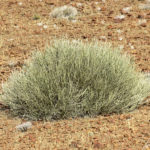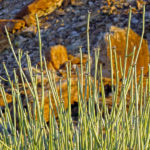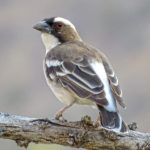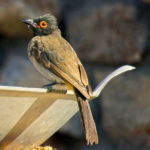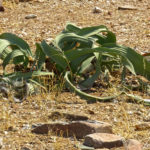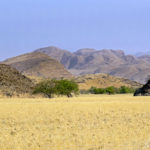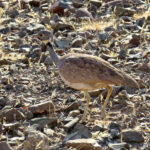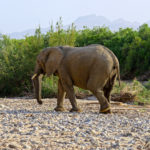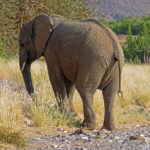The small town of Sesfontein and its surrounding area features unique fauna and flora. It lies in the Kunene region of northwestern Namibia between Kaokoland (Distant land) and Damaraland (Land of Damaras) and about 93 miles from the regional capital Opuwo. The name Sesfontein derives from the six springs which have their source in the region. The aridity of the area makes it home to unique fauna and flora. Some mammals, such as elephants and Hartmann’s zebras (more commonly known as Mountain zebras), have developed surprising ways to adapt to semi-arid conditions. As for the flora, it is quite simply fascinating. It includes the bottle tree, the shepherd’s tree, Salvadora Persica more commonly called “toothbrush tree” and especially the unique Welwitschia… Join us in our 4×4 for an impromptu safari and visit to the Palmwag Conservancy, a vast 1,740 square mile nature reserve, in search of the famous desert elephants and other Welwitschias !
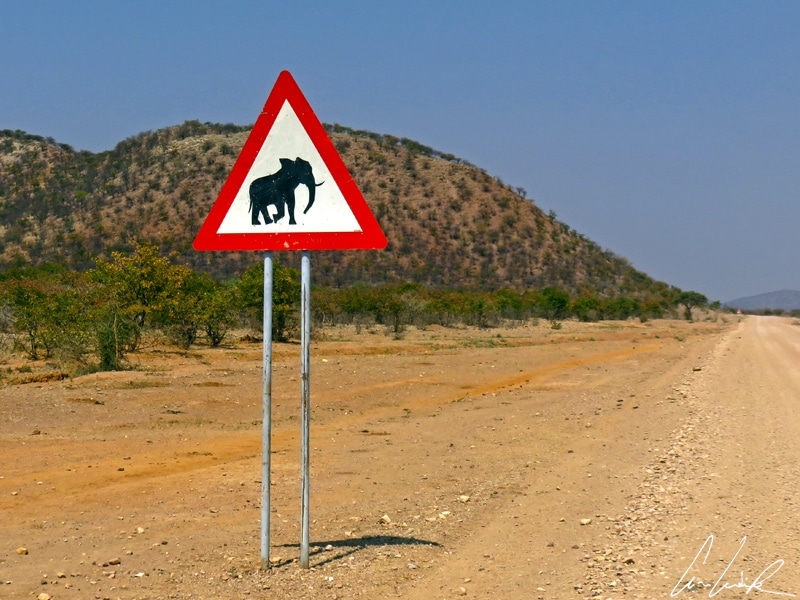
A dry and rocky landscape, home to Desert Elephants
From Sesfontein, the road, first paved and then unpaved, leads us to the Palmwag Conservancy; a Nature Reserve managed by local communities. The Palmwag Conservancy is located on the edge of the Skeleton Coast National Park. This arid area is home to Desert elephants, Mountain zebras, Oryx, Kudu and the last free Black rhinos of Southern Africa. A road sign “Elephant crossing” indicates that we are on the right road! However, at first glance, the place seems rather hostile. The landscape is arid, rocky, and dusty. Water is scarce and consequently so is vegetation. Desert elephants are at home in this arid environment, they say ? It is perhaps in such a dusty landscape that an elephant named Horton once heard a small noise calling for help from a speck of dust floating right by his ear…
« I knew it, I knew it, I knew it, there’s life on this speck (Horton)
The speck ? What speck ? (Ned McDodd, Mayor of Zouville)
Well, um… I don’t exactly know how to tell you this, but… you’re living on a speck (Horton)
Well, I hate to disagree with you, oh, Voice from the drain pipe, but I live in Zouville (Ned McDodd, Mayor of Zouville)
Well, then Zouville is a speck (Horton) »
Well, come on, whether Dr. Seuss likes it or not, we will not continue this speck of dust story. Let us return to our desert pachyderms (meaning thick-skinned) and continue our journey through the spectacular beauty of the Etendeka plateau.

The Etendeka Mountains dominate the landscape. “Etendeka” is a Herero word for “flat-topped mountain.” These impressive outcrops are in shades of grey and ochre. The terrain is rocky, and the granite hills spread their shattered and eroded blocks. The basalt has slowly eroded over the millennia, leaving granite blocks lying about in sometimes spectacular chaos..
Vegetation adapted to the semi-arid environment
The vegetation has adapted to both the intense heat of the sun and the lack of water. Although seemingly inhospitable the Etendeka Mountains are full of hidden life. Sterculia quinqueloba, more commonly called “talcum tree,” is recognizable by its white bark (hence the name…). It grows in the slightest crack in the rocks. The land is often covered with golden herbs and dotted with large bushes such as the Euphorbia Damarana, a plant endemic to the region. It is sometimes the only hint of green in the landscape ! The plant consists of slender and greys stems growing up to 8 feet tall. The shrub’s thin silvery stems contain milky, toxic latex capable of killing animals and humans except for rhinos, kudu, and Oryx, which eat them with impunity. The Bushmen apply the potent poison of the Euphorbia Damarana at the tip of their arrows for hunting. It is therefore, wise to stay away from these plants! If you want to grill your meat over a fire of dry branches of Euphorbia Damarana, it is at your own risk and may be your last dinner. Under no circumstances should you use this “dead wood” for a fire. It releases a toxin when it burns… Eating food cooked over a fire of Euphorbia Damarana can be fatal !
« Most men, like plants, have hidden properties which are discovered by chance »
(Réflexions morales – La Rochefoucauld)
In this semi-desert environment, plants can kill or heal. As good Bushmen, we need to learn how to tell one from the other. For example, the bottle tree, with its flared and smooth trunk, is easily identifiable. However, it is also one of the toxic plants…

We leave the arid plains and head to a hidden canyon. The vegetation is greener here, which suggests there is water somewhere. As we enter the canyon, we discover a shallow river. Some birds, like this brown Bulbul, are enjoying the water, but fly away as we approach. A captivating plant guards the banks of the riverbed. It is variable in size and shape, has bright green leaves, and appears to grow by becoming entangled with other trees. This small tree or shrub is the Salvadora persica, also known as “mustard tree” and by many other common names such as Arak, Jhak, and “toothbrush tree”. Salvadora persica has been used for teeth cleaning for centuries. Its cinnamon-colored twigs can serve as a toothbrush, hence the name “toothbrush tree.” This plant has protective and beneficial ingredients for oral hygiene (including tannins, mineral salts, vitamin C, Sulphur, phosphorus, silicon…,) which explains its extraordinary properties for gums and teeth. It is an eco-friendly product if you ever think of changing brands of toothpaste… Salvadora persica is also a vital plant for animals living in an arid environment because its leaves never fall off and the small fruits, red with a pleasant fragrance of mustard, serve as food. The bark and the roots are used to treat diseases such as diarrhea or fever.
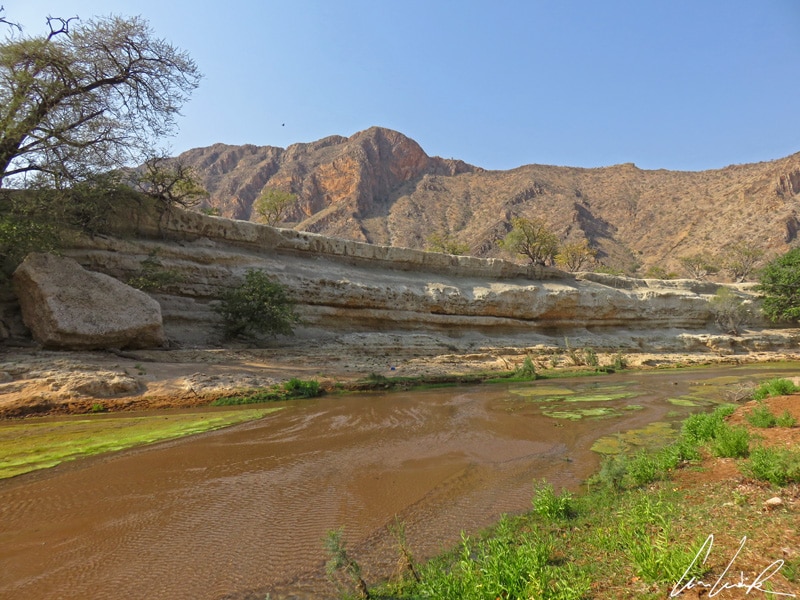
Welwitschia mirabilis: a thousand-year-old plant monstrously beautiful !
The other botanical curiosity of this vast, rugged area is the Welwitschia mirabilis (mirabilis meaning wonderful). This plant is endemic to the Namib Desert and to Angola. It is locally called “Kharos” (meaning “long life”) for its life span is estimated at 2000 years. People call it a living fossil ! Its entangled foliage at ground level looks like the undulating tentacles of an octopus stranded in the middle of the desert. Not only is its appearance fascinating but so its physiology. It is composed of a woody, fibrous unbranched main stem with an elongated deep taproot system that goes down several feet into the earth. It also has an extensive network of non-tapering extensions, lateral and spongy roots. It takes its name from the Austrian botanist Friedrich Welwitch (1806-1872) who discovered the plant in 1860 in the Namib Desert. Welwitschia mirabilis consists of two leaves reaching lengths up to 13 feet. The growth of these two opposing leaves is continuous but very slow, which means that the ends are often torn by the wind and friction with the ground. British botanist J. D. Hooker (1817-1911) used Welwitsch’s description as the basis for an in-depth study of the plant. He described Welwitschia mirabilis in these fairly accurate terms:
« It is undoubtedly not only the most wonderful plant ever brought to this country but also the ugliest ! »
(1862 – excerpt from the correspondence between J.D. Hooker et T. H. Huxley)
This Frankenstein of a plant fascinates scientists. Beyond its anatomical features, Welwitschia mirabilis intrigues botanists even more by its way of life. Indeed, it is full of biological quirks and displays a whole series of characters that are a priori “not-adapted” to life in an arid environment. Yet, the plant has survived for thousands of years! The age of any given plant is difficult to assess, but plants aged 400 to 600 years are frequently found. Some specimens may be over 1000 and some over 2000 years old according to carbon-14 dating. Welwitschia mirabilis does not correspond to any of the categories of xerophytes (plants living in an arid environment) because it breaks all the rules: its large permanent leaves, whose surface may attain an area of eleven square feet protect from sunburn! The leaves spread across the ground trapping heat rather than letting it escape into the air… Besides, the leaves have no water storage devices or protective hair coating. Knowing that a medium-sized plant loses about one liter of water every day by evaporation, our Welwitschia mirabilis appears as a real madman wasting water in an extreme environment !
« “[…] the only people for me are the mad ones, the ones who are mad to live, mad to talk, mad to be saved, desirous of everything at the same time »
(Jack Kerouac, American writer, and poet)
Yes, Jack, this crazy vegetable freaks us out! How does this shrub survive against all the odds? A small part of the answer lies in its advanced root system. Welwitschia takes in water from condensation or rainwater run-off. For the rest, “appearances are deceiving” as the idiom says! A thick, waxy coating covers the surface of its leaves. This is what gives the leaves their bluish-green hue. This coating is an impermeable film that limits water loss while reflecting light and heat. Another evolutionary innovation lies in the consistency of the leaves, which are incredibly tough, thanks to their fibers. A layer of calcium oxalate crystals lies just below the surface and plays a significant role in the reflection of light (leaves absorb only 55% of solar radiation), which limits heating and potential radiation damage.
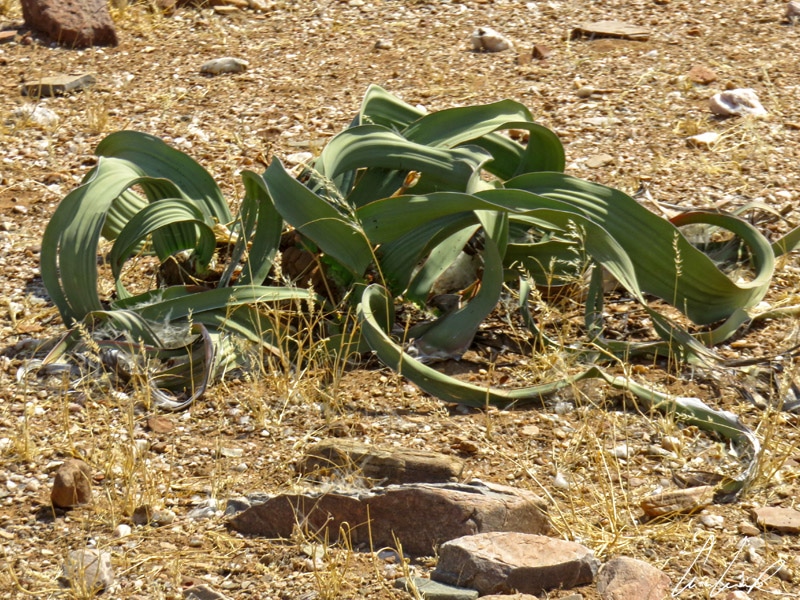
Welwitschia mirabilis is also unique in its method of reproduction. The species is dioecious, meaning there are separate male and female plants. Male plants bear elongated cones or strobili. The strobili have a salmon color and then turn to a shade of brown. Female plants develop twigs with rounded yellowish-green cones. Both male and female strobili produce nectar in abundance, which attracts insects and promotes fertilization. After the first rainfall, the seeds develop in three weeks, but it then takes 25 years for the very first flower to appear… We could almost say that we do not know the sex of the child before the age of 25 !
Tracking desert adapted elephants !
Back to the plain, covered with golden herbs against the backdrop of the Etendeka Mountains. We tirelessly survey the horizon in search of desert pachyderms. Survival is a daily challenge for wildlife. In this vast rugged and stony area, our path crosses that of a male Rüppell’s Korhaan, also known as Rüppell’s Bustard (Eupododis rueppellii). The bird is about 24 inches long and easily recognizable by its head and grey-blue neck with black stripes down its throat. The Rüppell’s Korhaan is native to both Angola and Namibia in southwestern Africa. The bird is named after the German naturalist Wilhelm Rüppell (1794-1884.) Due to its morphology, the Rüppell’s Korhaan is better suited for walking and running than for flying. She runs when she is disturbed, but flies willingly when she is in a hurry. It has a distinctive call that can be heard from afar and is similar to that of a frog: “Kraak-rak” or “Crook-rak-rak”. I do not know any fairy tale that mentions a bustard turning into a prince after a kiss…
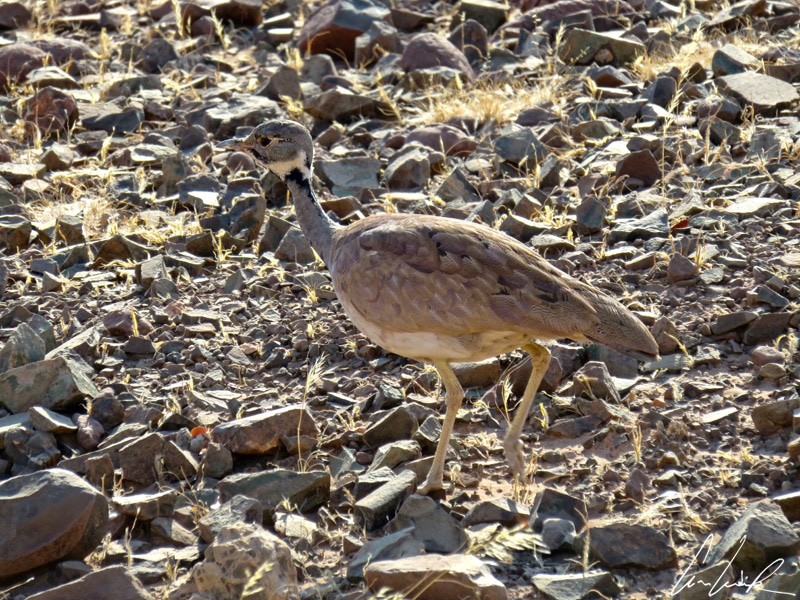
Our 4WD moves slowly, to avoid frightening any animals that may cross our path, but also to allow us to observe the horizon and get a chance to spot our friend with a trunk. While driving along a dry riverbed, we keep our eyes wide open… We have just seen a footprint in a muddy area. Like the characters in Lauren St John’s novel, Juliette and Ben, we have the impression that we are investigating a desert where elephants have mysteriously disappeared… Unfortunately for us, I do not have Juliette’s gift for communicating with animals. A fine spray of water runs over the surface after we splash through a puddle. If water is near, elephants are not far either. Suddenly, several feet away, an entire family of elephants roams throughout the wet area. However, is it real or is it just a mirage? Ever since our earliest childhood we have been told:
« An elephant is deceiving, deceiving, deceiving,
An elephant is very deceiving »
(Nursery rhyme)
Unlike other African elephants, Desert elephants, or desert-adapted elephants, live in small herds. Often these pachyderms have to travel long distances to find water. Desert elephants drink up to 42 gallons a day, but they can go without water for up to 3 days at the time, a way to preserve the desert’s water supply. Without knowing hidden water points, most elephants hydrate with the food they ingest. The smallest little green leaf contains some water and is better than nothing. These elephants take the greatest care for the source of their food, much more than the pachyderms that live in wetter environments in other parts of Africa. Instead of pulling out the plants with their roots, they gently harvest the young shoots so that the shrubs can continue to grow. Desert elephants are herbivorous. They graze for about 20 hours a day, consuming nearly 450 pounds of plants. They may travel over large areas to feed themselves, which is why they have bigger feet. They are always on the move. A healthy Desert elephant travels up to 6,000 miles a year in search of food. They have adapted to their dry and semi-desert life with boarder feet, longer legs, and a smaller body compared to other African elephants.

Zoologists and scientists have long questioned whether Desert elephants should be classified as a different species or as a subspecies. Although Desert elephants are particularly well adapted to life in the arid conditions of the desert, their DNA reveals that they are not a distinct subspecies of elephants. They are simply African bush elephants. Other than a few details, they are not much different from their brothers the Savannah elephants (Loxodonta Africana). They have simply adapted to the harsh conditions of the desert. For example, broader feet prevent them from sinking into the sand. Due to their adaptation to the environment, Desert elephants are also skilled climbers. They reproduce half as much as their counterparts living in other ecosystems and are thus better able to prepare their offspring for extreme conditions. For example, females double the breastfeeding period. A recent scientific study also suggests that these elephants transmit their survival knowledge and skills to future generations to help them to adapt to tough environmental conditions.
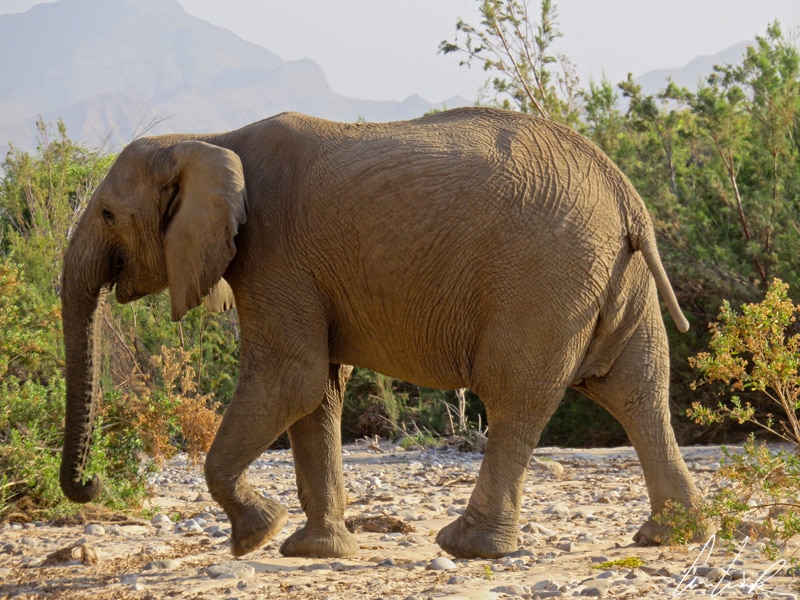
Four of them are feeding a few feet away from us. They are so close to us and so comfortable that it is almost disturbing. I felt as if time had stopped, but it was more than that. I was suspended in time. I can watch an elephant feeding just ten feet away from me. I can examine all the details of its trunk, which is activated by dozens of muscles. It is both nose and a gentle hand that caresses and a weapon to strike enemies. The nostrils are at its tip, and the elephant can raise the trunk to smell the air… a kind of radar. At the conclusion of the meal, the patriarch gives the signal. The elephants leave as they appeared, nonchalantly in a cloud of dust. We remain motionless for a few moments, hypnotized by what we have just witnessed….
« I’m a poor lonesome elephant
I’ve a long long way from home
And this poor lonesome elephant
Has got a long long way to home
Over mountains and over prairies »

